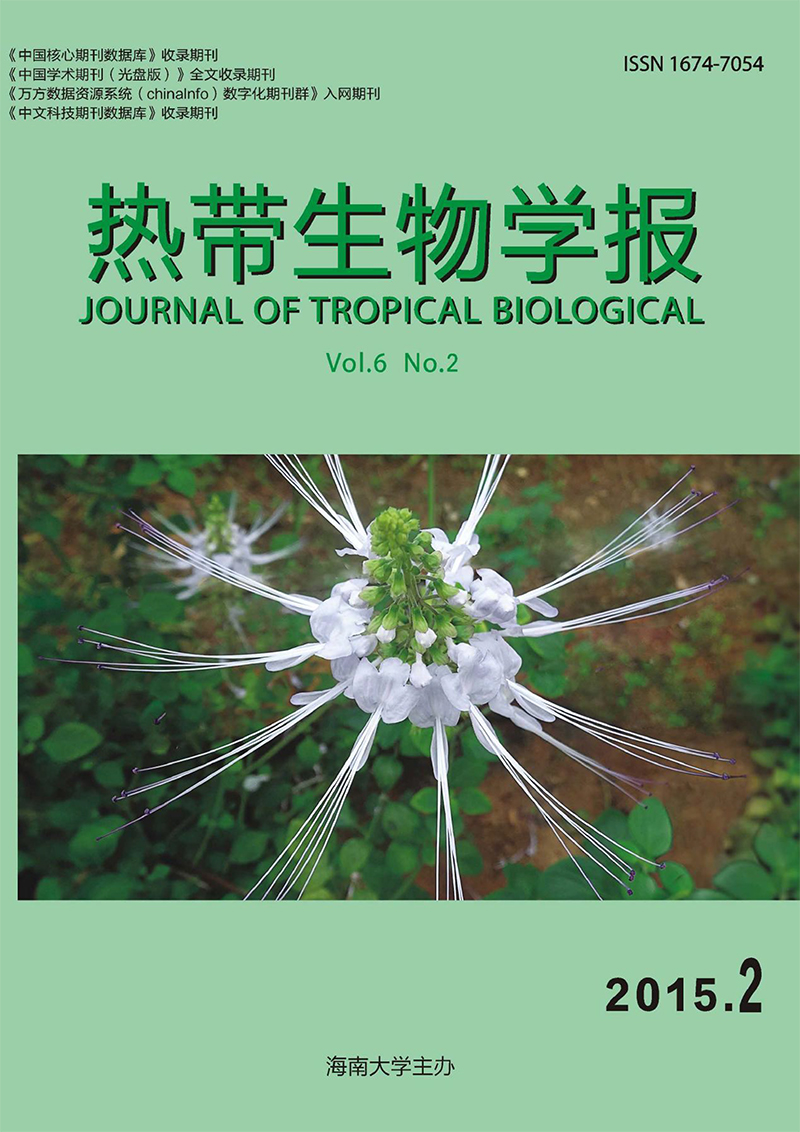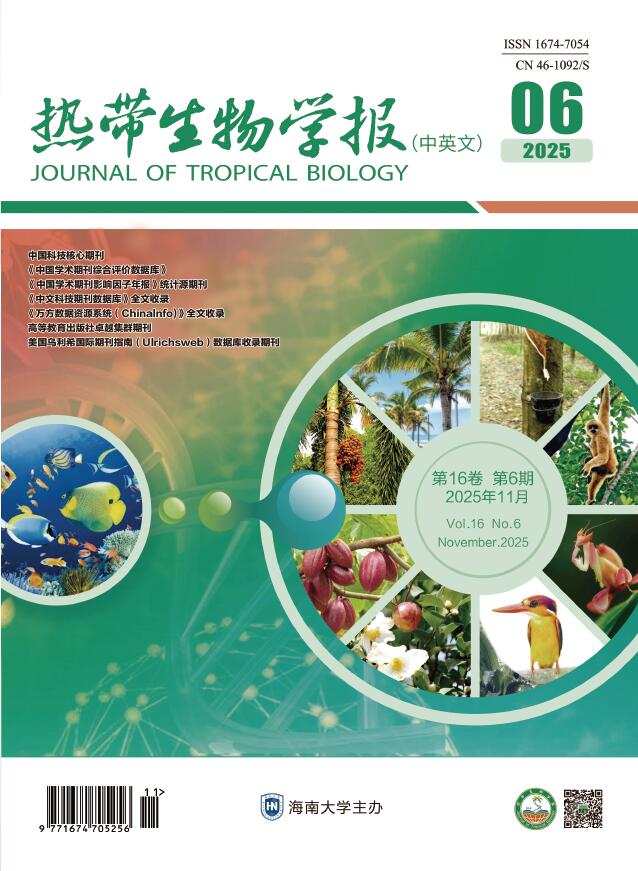2015 Vol. 6, No. 2
column
2015, 6(2): 105-112.
doi: 10.15886/j.cnki.rdswxb.2015.02.001
Abstract:
A ferric-chelate reductase gene of rubber tree( Hevea brasiliensis) was cloned by RT-PCR and named as HbFRO based on the data of RNA-Seq of rubber tree. The sequencing result revealed that the ORF of HbFRO is 221 7 bp,encoding a 739 amino acids peptides. Bioinformatics analysis showed that the HbFRO protein contains conserved Ferric_reduct,FAD_binding and NAD_binding domains,which are similar to those of the FRO from other plants,and had ten transmembrane domains. The amino acid sequence of HbFRO is 85%,80%,73% and 63% similar to that of the FRO from Manihot esculenta,Ricinus communis,Populus tomentosa and Arabidopsis thaliana,respectively. Semi-quantitative RT-PCR analysis showed that the expression level of the HbFRO was significantly higher in leaf,flower and latex than in bark and buds,but was significantly decreased in leaves inoculated with Colletotrichum gloeosporoiodes and Odium heveae Steinm. These implied that the HbFRO was differently expressed in different tissues and probably involved in disease defense.
A ferric-chelate reductase gene of rubber tree( Hevea brasiliensis) was cloned by RT-PCR and named as HbFRO based on the data of RNA-Seq of rubber tree. The sequencing result revealed that the ORF of HbFRO is 221 7 bp,encoding a 739 amino acids peptides. Bioinformatics analysis showed that the HbFRO protein contains conserved Ferric_reduct,FAD_binding and NAD_binding domains,which are similar to those of the FRO from other plants,and had ten transmembrane domains. The amino acid sequence of HbFRO is 85%,80%,73% and 63% similar to that of the FRO from Manihot esculenta,Ricinus communis,Populus tomentosa and Arabidopsis thaliana,respectively. Semi-quantitative RT-PCR analysis showed that the expression level of the HbFRO was significantly higher in leaf,flower and latex than in bark and buds,but was significantly decreased in leaves inoculated with Colletotrichum gloeosporoiodes and Odium heveae Steinm. These implied that the HbFRO was differently expressed in different tissues and probably involved in disease defense.
2015, 6(2): 113-118.
doi: 10.15886/j.cnki.rdswxb.2015.02.002
Abstract:
Zinc-finger is a protein that binds DNA / RNA and regulates gene expression. In previous work,we identified a Zinc-finger protein( termed as Hb Zinc-finger) that interacted with Hb JAZ1 in Y2 H against rubber latex c DNA yeast library. The full-length c DNA of Hb Zinc-finger gene is 2 262 bp in length and encodes 753 aa.C-terminal of Hb Zinc-finger contains a PB1 domain. A ZnF_ZZ domain exists between 336 aa and 381 aa. Subcellular fluorescent localization result showed that the Hb Zinc-finger was located in nucleus. Additionally,Hb Zinc-finger showed strong self transcriptional activation in yeast. Furthermore,the expression of Hb Zinc-finger was affected by continuously wounding in rubber latex,suggesting that Hb Zinc-finger is possibly regulated by the JA signaling pathway.
Zinc-finger is a protein that binds DNA / RNA and regulates gene expression. In previous work,we identified a Zinc-finger protein( termed as Hb Zinc-finger) that interacted with Hb JAZ1 in Y2 H against rubber latex c DNA yeast library. The full-length c DNA of Hb Zinc-finger gene is 2 262 bp in length and encodes 753 aa.C-terminal of Hb Zinc-finger contains a PB1 domain. A ZnF_ZZ domain exists between 336 aa and 381 aa. Subcellular fluorescent localization result showed that the Hb Zinc-finger was located in nucleus. Additionally,Hb Zinc-finger showed strong self transcriptional activation in yeast. Furthermore,the expression of Hb Zinc-finger was affected by continuously wounding in rubber latex,suggesting that Hb Zinc-finger is possibly regulated by the JA signaling pathway.
2015, 6(2): 119-126.
doi: 10.15886/j.cnki.rdswxb.2015.02.003
Abstract:
Xanthomonas campestris pv. campestris( Xcc),a Gram-negative plant pathogenic bacterium,can cause black rot diseases on crucifer plants,including cabbage,radish and Arabidopsis. Xcc secrets effector proteins into plants via the type Ⅲ secretion system to help its infection and reproduction. HpaA protein widely exists in Xanthomonas,and it has been reported that HpaAXcv85-10 is a type Ⅲ effector and participates in other effector secretion in X. campestris pv. vesicatoria( Xcv). Xcc contains the HpaA protein homologue. However,it is not clear whether the HpaAXcc protein can be secreted in type Ⅲ secretion system,and the mechanism of hpaAXcc remains unclear. In this study,secretion assay indicated the HpaAXcc8004 protein secretion was type Ⅲ secretion system dependent. Subcellular localization assay indicated that HpaAXcc8004 was located in the plant cell nucleus,which was consistent with HpaAXcv85-10 protein location in plants. In addition,the deletion mutant of HpaA gene was achieved by means of homologous recombination,and the deletion mutant caused reduced symptoms in cabbage,radish and Arabidopsis thanliana,which indicated that HpaAXcc8004 was required for the Xcc8004 complete toxicity in the host plants. Furthermore,in the HpaA transgenic Arabidopsis,HpaAXcc8004 can perform its function to reduce the chlorosis symptoms caused by Pseudomonas DC3000 and Xcc8004.
Xanthomonas campestris pv. campestris( Xcc),a Gram-negative plant pathogenic bacterium,can cause black rot diseases on crucifer plants,including cabbage,radish and Arabidopsis. Xcc secrets effector proteins into plants via the type Ⅲ secretion system to help its infection and reproduction. HpaA protein widely exists in Xanthomonas,and it has been reported that HpaAXcv85-10 is a type Ⅲ effector and participates in other effector secretion in X. campestris pv. vesicatoria( Xcv). Xcc contains the HpaA protein homologue. However,it is not clear whether the HpaAXcc protein can be secreted in type Ⅲ secretion system,and the mechanism of hpaAXcc remains unclear. In this study,secretion assay indicated the HpaAXcc8004 protein secretion was type Ⅲ secretion system dependent. Subcellular localization assay indicated that HpaAXcc8004 was located in the plant cell nucleus,which was consistent with HpaAXcv85-10 protein location in plants. In addition,the deletion mutant of HpaA gene was achieved by means of homologous recombination,and the deletion mutant caused reduced symptoms in cabbage,radish and Arabidopsis thanliana,which indicated that HpaAXcc8004 was required for the Xcc8004 complete toxicity in the host plants. Furthermore,in the HpaA transgenic Arabidopsis,HpaAXcc8004 can perform its function to reduce the chlorosis symptoms caused by Pseudomonas DC3000 and Xcc8004.
2015, 6(2): 127-133.
doi: 10.15886/j.cnki.rdswxb.2015.02.004
Abstract:
A Na+/H+ antiporter gene SpNHX1 from Sesuvium portulacastrumand L. was cloned by using PCR methods. Bioinformation analysis showed that SpNHX1 shared higher identity with At NHX1( 76. 35%) and AtNHX2( 77. 12%),which indicated that the protein SpNHX1 might have similar function as At NHX1 and AtNHX2 that compartmentalize excessive Na+into vacuole,thus improving plant salt tolerance. Real-time PCR was used for identification of the expression levels of the gene SpNHX1 under 4 different stress treatments,600mmol·L-1 Na Cl,100 μmol·L-1ABA,low temperature at 4℃,and 20% PEG6000 drought stress. The gene SpNHX1 was up-regulated in the roots and stems other than in leaves under salt stress. Hardly clear expression tendency of SpNHX1 was observed under 100 μmol · L-1ABA,low temperature at 4℃,and drought stress.These illustrated that the expression of the gene SpNHX1 was related to plant salt tolerance,and its expression was tissue-specific.
A Na+/H+ antiporter gene SpNHX1 from Sesuvium portulacastrumand L. was cloned by using PCR methods. Bioinformation analysis showed that SpNHX1 shared higher identity with At NHX1( 76. 35%) and AtNHX2( 77. 12%),which indicated that the protein SpNHX1 might have similar function as At NHX1 and AtNHX2 that compartmentalize excessive Na+into vacuole,thus improving plant salt tolerance. Real-time PCR was used for identification of the expression levels of the gene SpNHX1 under 4 different stress treatments,600mmol·L-1 Na Cl,100 μmol·L-1ABA,low temperature at 4℃,and 20% PEG6000 drought stress. The gene SpNHX1 was up-regulated in the roots and stems other than in leaves under salt stress. Hardly clear expression tendency of SpNHX1 was observed under 100 μmol · L-1ABA,low temperature at 4℃,and drought stress.These illustrated that the expression of the gene SpNHX1 was related to plant salt tolerance,and its expression was tissue-specific.
2015, 6(2): 134-140.
doi: 10.15886/j.cnki.rdswxb.2015.02.005
Abstract:
Stem cell pluripotency genes play a key role in the early development of animals. According to known species’ stem cell pluripotency genes,four genes( Oct4,Nanog,Sox2 and c-Myc) were cloned by using the homologue-sequence method from the earthworm Eisenia foetida. The expression of these four genes was detected by the real-time fluorescence quantitative PCR in the earthworm E. foetida at the early development stage. The expression of the four genes was escalated gradually from day 0 to 21,the highest at 21 d at the cocoon hatching stage,but declined at day 28. Three genes Oct4,Nanog and c-Myc were detected to have higher expression at the larval stage than at the cocoon hatching stage. This suggested that the four genes had similar expression pattern and might have a synergistic effect during the early development of Eisenia fetida.
Stem cell pluripotency genes play a key role in the early development of animals. According to known species’ stem cell pluripotency genes,four genes( Oct4,Nanog,Sox2 and c-Myc) were cloned by using the homologue-sequence method from the earthworm Eisenia foetida. The expression of these four genes was detected by the real-time fluorescence quantitative PCR in the earthworm E. foetida at the early development stage. The expression of the four genes was escalated gradually from day 0 to 21,the highest at 21 d at the cocoon hatching stage,but declined at day 28. Three genes Oct4,Nanog and c-Myc were detected to have higher expression at the larval stage than at the cocoon hatching stage. This suggested that the four genes had similar expression pattern and might have a synergistic effect during the early development of Eisenia fetida.
2015, 6(2): 141-146.
doi: 10.15886/j.cnki.rdswxb.2015.02.006
Abstract:
To study the biological function of OsCERK2 gene,we constructed the OsCERK2 gene overexpression and RNA interference vectors by modifying p CAMBIA1300 and p TCK303 as framework plasmid,and then transferred the vectors respectively into the rice through Agrobacterium-mediated genetic transformation. Molecular detection produced four overexpressing homozygous lines and two RNAi homozygous lines with reduced transcriptional level. The transgenic plants of the OE lines and RNAi lines were sprayed with peptidoglycan prepared from the cell wall of both race PXO99( Xoo- R6) of Xanthomonas oryzae pv. oryzae( PGNXoo) and the strain JB01-25 of X. oryzae pv. oryzicola( PGNXoc) and Chitin Mo from the cell wall of Magnaporthe oryzae,with water as control. The expression of pathogenesis related( PR) genes were determined by using the semi-quantitative RTPCR. The results showed that the plants of overexpressing lines improved the expression of their PR genes while the plants of RNAi expressing line reduced the expression of the PR genes,as compared with the nontransgenic rice. Furthermore,the plants of overexpressing transgenic lines exhibited high tolerance to PXO99,but there were not significantly different between the RNAi plants and the wild type. These results indicated that OsCERK2 overexpressing gene may be an effective way to disease tolerance of rice.
To study the biological function of OsCERK2 gene,we constructed the OsCERK2 gene overexpression and RNA interference vectors by modifying p CAMBIA1300 and p TCK303 as framework plasmid,and then transferred the vectors respectively into the rice through Agrobacterium-mediated genetic transformation. Molecular detection produced four overexpressing homozygous lines and two RNAi homozygous lines with reduced transcriptional level. The transgenic plants of the OE lines and RNAi lines were sprayed with peptidoglycan prepared from the cell wall of both race PXO99( Xoo- R6) of Xanthomonas oryzae pv. oryzae( PGNXoo) and the strain JB01-25 of X. oryzae pv. oryzicola( PGNXoc) and Chitin Mo from the cell wall of Magnaporthe oryzae,with water as control. The expression of pathogenesis related( PR) genes were determined by using the semi-quantitative RTPCR. The results showed that the plants of overexpressing lines improved the expression of their PR genes while the plants of RNAi expressing line reduced the expression of the PR genes,as compared with the nontransgenic rice. Furthermore,the plants of overexpressing transgenic lines exhibited high tolerance to PXO99,but there were not significantly different between the RNAi plants and the wild type. These results indicated that OsCERK2 overexpressing gene may be an effective way to disease tolerance of rice.
2015, 6(2): 147-152.
doi: 10.15886/j.cnki.rdswxb.2015.02.007
Abstract:
Hainan has abundant germplasm resources of common wild rice( Oryza rufipogon Griff.) which is important for hereditary improvement of cultivated rice( Oryza sativa L). A wild rice germplasm resources database system based on B / S structure was built on the basis of the inventory,recording and collection of the wild rice germplasm. The data was generated or collected according to the "Wild rice germplasm resources description and data standard",and this database system with data managing and querying function also includes the data of the morphological characteristics and origin of wild rice as well as its geographic information and the local rice production. With this system we can get a comprehensive understanding of germplasm characteristics of the wild rice populations and set it as a service platform for scientific management of the common wild rice and data-sharing in Hainan Province,China.
Hainan has abundant germplasm resources of common wild rice( Oryza rufipogon Griff.) which is important for hereditary improvement of cultivated rice( Oryza sativa L). A wild rice germplasm resources database system based on B / S structure was built on the basis of the inventory,recording and collection of the wild rice germplasm. The data was generated or collected according to the "Wild rice germplasm resources description and data standard",and this database system with data managing and querying function also includes the data of the morphological characteristics and origin of wild rice as well as its geographic information and the local rice production. With this system we can get a comprehensive understanding of germplasm characteristics of the wild rice populations and set it as a service platform for scientific management of the common wild rice and data-sharing in Hainan Province,China.
2015, 6(2): 153-157.
doi: 10.15886/j.cnki.rdswxb.2015.02.008
Abstract:
Eggplant bacterial wilt( Ralstonia solanacearum) is a major disease in eggplant( Solanum melongena),and selection of root stocks resistant to R. solanacearum is a better way to control this disease. Fifteen eggplant root stocks collected were grafted with the scions of eggplant variety Changfeng 2 to evaluate their resistance to R. solanacearum. The eggplant root stocks and their graftings were wounded in the root and inoculated with bacterial solution of R. solanacearum by drenching. Of all the eggplant root stocks,4( Qing Lian 606,Qing Lian 605,Qing Lian 530 and Ding Qie) were found highly resistant,5 moderately resistant,2 susceptible,4 highly susceptible to R. solanacearum. In the eggplant plants grafted onto 15 root stocks,3( Qinglian 530,Qing Lian 605 and Qing Lian 606) were highly resistant,2 resistant,5 moderately resistant,4( such as Ding Qie) susceptible and 1 highly susceptible. Root stocks Qinglian 530,Qing Lian 605 and Qing Lian 606 which are local wild eggplants,and their graftings started to show disease symptoms 5 or 10 days after inoculation.Some of these plants displayed withered leaves at the early stage of disease infection. Their disease indexes were low after the disease turned stable. All of these root stocks and their graftings were highly tolerant. However,the other root stocks,highly susceptible or susceptible,and their graftings started to be infected with R. solanacearum 5 days after inoculation,and the bacterial wilt disease turned to be stable 60 days after inoculation.Their disease indexes were above 54. 44,and most of the plants died 70 days after inoculation. The root stocks Qinglian 530,Qinglian 605,Qinglian 606 and their graftings were highly resistant to R. solanacearum,and hence are promising materials for root stocks.
Eggplant bacterial wilt( Ralstonia solanacearum) is a major disease in eggplant( Solanum melongena),and selection of root stocks resistant to R. solanacearum is a better way to control this disease. Fifteen eggplant root stocks collected were grafted with the scions of eggplant variety Changfeng 2 to evaluate their resistance to R. solanacearum. The eggplant root stocks and their graftings were wounded in the root and inoculated with bacterial solution of R. solanacearum by drenching. Of all the eggplant root stocks,4( Qing Lian 606,Qing Lian 605,Qing Lian 530 and Ding Qie) were found highly resistant,5 moderately resistant,2 susceptible,4 highly susceptible to R. solanacearum. In the eggplant plants grafted onto 15 root stocks,3( Qinglian 530,Qing Lian 605 and Qing Lian 606) were highly resistant,2 resistant,5 moderately resistant,4( such as Ding Qie) susceptible and 1 highly susceptible. Root stocks Qinglian 530,Qing Lian 605 and Qing Lian 606 which are local wild eggplants,and their graftings started to show disease symptoms 5 or 10 days after inoculation.Some of these plants displayed withered leaves at the early stage of disease infection. Their disease indexes were low after the disease turned stable. All of these root stocks and their graftings were highly tolerant. However,the other root stocks,highly susceptible or susceptible,and their graftings started to be infected with R. solanacearum 5 days after inoculation,and the bacterial wilt disease turned to be stable 60 days after inoculation.Their disease indexes were above 54. 44,and most of the plants died 70 days after inoculation. The root stocks Qinglian 530,Qinglian 605,Qinglian 606 and their graftings were highly resistant to R. solanacearum,and hence are promising materials for root stocks.
2015, 6(2): 158-162.
doi: 10.15886/j.cnki.rdswxb.2015.02.009
Abstract:
The fruit flesh,leaves,freeze-dried powder of fruit,and fermented fruit juice of Noni( Morinda citrifolia L.) were determined in terms of mineral elements,K,Ca,Na,Mg,Fe,Zn and Mn,by using Air-acetylene flame atomic absorption spectrometry. These elements had a recovery rate ranging from 94% to 107. 2%. Noni was found to contain high K,Ca,Zn,Fe and Mn. In the fruit flesh K content was the highest,upto 24 215. 81μg·g-1 while the Na content was relatively lower,only 789. 4 μg·g-1. Noni is hence a typical low-sodium and highpotassium food with high healthcare value. The leaves contained higher elements except K than the fruit flesh,especially Fe,Zn and Mn,and hence have a good value for development. The freeze-dried fruit powder contained similar elements to the fruit flesh. The fermented fruit juice contained elements proportionate to the fruit flesh of the same variety of Noni,and the content of the elements was found to meet the needs of human being.
The fruit flesh,leaves,freeze-dried powder of fruit,and fermented fruit juice of Noni( Morinda citrifolia L.) were determined in terms of mineral elements,K,Ca,Na,Mg,Fe,Zn and Mn,by using Air-acetylene flame atomic absorption spectrometry. These elements had a recovery rate ranging from 94% to 107. 2%. Noni was found to contain high K,Ca,Zn,Fe and Mn. In the fruit flesh K content was the highest,upto 24 215. 81μg·g-1 while the Na content was relatively lower,only 789. 4 μg·g-1. Noni is hence a typical low-sodium and highpotassium food with high healthcare value. The leaves contained higher elements except K than the fruit flesh,especially Fe,Zn and Mn,and hence have a good value for development. The freeze-dried fruit powder contained similar elements to the fruit flesh. The fermented fruit juice contained elements proportionate to the fruit flesh of the same variety of Noni,and the content of the elements was found to meet the needs of human being.
2015, 6(2): 163-167.
doi: 10.15886/j.cnki.rdswxb.2015.02.010
Abstract:
Ancistrocladus tectorius was extracted with ethyl alcohol( Et OH),and the active constituents of the Et OH and their biological activities against malaria were determined. Mice infected with Plasmodium berghei were treated with the Et OH extract,and its cytotoxic activity was assayed by the MTT method. The antimicrobial activities of the Et OH extract were tested by the paper disk diffusion method,and its acetylcholinesterase inhibitory activity was detected by using the Ellman’s colorimetric method. The results indicated that the Et OH extract of A.tectorius inhibited the growth of malaria parasites and improved the survival rate of the mice infected with P.berghei. It also possessed inhibitory activity against K562,SGC-7721 and BEL-7402 cell lines,as well as human and agricultural pathogens. Moreover,it showed lower inhibitory activity against acetylcholinesterase than Tacrine.
Ancistrocladus tectorius was extracted with ethyl alcohol( Et OH),and the active constituents of the Et OH and their biological activities against malaria were determined. Mice infected with Plasmodium berghei were treated with the Et OH extract,and its cytotoxic activity was assayed by the MTT method. The antimicrobial activities of the Et OH extract were tested by the paper disk diffusion method,and its acetylcholinesterase inhibitory activity was detected by using the Ellman’s colorimetric method. The results indicated that the Et OH extract of A.tectorius inhibited the growth of malaria parasites and improved the survival rate of the mice infected with P.berghei. It also possessed inhibitory activity against K562,SGC-7721 and BEL-7402 cell lines,as well as human and agricultural pathogens. Moreover,it showed lower inhibitory activity against acetylcholinesterase than Tacrine.
2015, 6(2): 168-172.
doi: 10.15886/j.cnki.rdswxb.2015.02.011
Abstract:
Extracting high quality DNA is very important for molecular experiments. Dendrobium species under the family Orchidaceae contain more sucrose and polyphenol substances and,it is hence difficult to extract high quality DNA from Dendrobium species. Six methods were used to extract DNA from 7 Dendrobium species,and compared to develop an optimal extracting method for DNA. Both PEX-improved method and CTAB-improved method had positive effect on DNA extraction from Dendrobium spp. which contained more polysaccharides and polyphenols. Compared with other 5 methods,the PEX-improved method removed higher content of polysaccharides and phenolics from Dendrobium spp and met the need of molecular biology experiments. The CTAB-improved method and the SDS-improved method removed more content of polysaccharides,and produced higher yield DNA samples as compared with the CTAB method and the SDS method.
Extracting high quality DNA is very important for molecular experiments. Dendrobium species under the family Orchidaceae contain more sucrose and polyphenol substances and,it is hence difficult to extract high quality DNA from Dendrobium species. Six methods were used to extract DNA from 7 Dendrobium species,and compared to develop an optimal extracting method for DNA. Both PEX-improved method and CTAB-improved method had positive effect on DNA extraction from Dendrobium spp. which contained more polysaccharides and polyphenols. Compared with other 5 methods,the PEX-improved method removed higher content of polysaccharides and phenolics from Dendrobium spp and met the need of molecular biology experiments. The CTAB-improved method and the SDS-improved method removed more content of polysaccharides,and produced higher yield DNA samples as compared with the CTAB method and the SDS method.
2015, 6(2): 173-179.
doi: 10.15886/j.cnki.rdswxb.2015.02.012
Abstract:
The typical basalt-derived latosol was selected from Hainan area to study the influence of biochar and straw on soil p H,exchangeable acid and exchange performance. The trial consisted of 4 treatments: control( CK),biochar( B),biochar and corn straw mixture( BCS),corn straw( CS). The trial results shawed addition of biomass materials,jmproved the soil p H,to some extents,reduled obviously the soil exchangeable acid,and improved signifilantly the soil cation capacity( CEL) exchangeable base and base saturation with the treatment effect in the order of CS > BCS > B > CK.
The typical basalt-derived latosol was selected from Hainan area to study the influence of biochar and straw on soil p H,exchangeable acid and exchange performance. The trial consisted of 4 treatments: control( CK),biochar( B),biochar and corn straw mixture( BCS),corn straw( CS). The trial results shawed addition of biomass materials,jmproved the soil p H,to some extents,reduled obviously the soil exchangeable acid,and improved signifilantly the soil cation capacity( CEL) exchangeable base and base saturation with the treatment effect in the order of CS > BCS > B > CK.
2015, 6(2): 180-188.
doi: 10.15886/j.cnki.rdswxb.2015.02.013
Abstract:
A field survey and a questionnaire were made to investigate and analyze the species of aromatic plants in the major urban parks in Haikou City,Hainan Province. The investigations found that there are 100 aromatic plants in the green land of the urban parks in Haikou,belonging to 84 genera and 44 families. The major plant species belong to the families Myrtaceae,Apocynaceae,Magnoliaceae and Oleaceae. These aromatic plants grow as avenue trees,landscape trees,decorated hedge shrubs,flower plants,landscape forest,and vertical greening. There are some problems arising from he landscape application of the aromatic plants,such as low species diversity,imbalance of species structure,and improper management. In this context some suggestions concerning the introduction,selection and planting of aromatic plant species in urban parks in Haikou are put forward based on the analysis.
A field survey and a questionnaire were made to investigate and analyze the species of aromatic plants in the major urban parks in Haikou City,Hainan Province. The investigations found that there are 100 aromatic plants in the green land of the urban parks in Haikou,belonging to 84 genera and 44 families. The major plant species belong to the families Myrtaceae,Apocynaceae,Magnoliaceae and Oleaceae. These aromatic plants grow as avenue trees,landscape trees,decorated hedge shrubs,flower plants,landscape forest,and vertical greening. There are some problems arising from he landscape application of the aromatic plants,such as low species diversity,imbalance of species structure,and improper management. In this context some suggestions concerning the introduction,selection and planting of aromatic plant species in urban parks in Haikou are put forward based on the analysis.
2015, 6(2): 189-196.
doi: 10.15886/j.cnki.rdswxb.2015.02.014
Abstract:
The TLC fingerprints of ether extract of ten agarwood samples from Aquilaria sinensis were established by using the thin-layer chromatography( TLC) with two developing solvents and three observation methods,UV 254 nm,UV 365 nm and visualization reagent 5% vanillin sulfuric acid / ethanol. The results show that the TLC fingerprinting method was precise,repeatable and stable,meeting the fingerprint qualification. The ten batches of agarwood samples showed 17 common fluorescent spots,of which seven spots were characterized,including 4 chronmones,2 sesquiterpenes and a sitosterol. The TLC fingerprinting could quickly,intuitively and reliably reflect the whole characteristics,distinguish agarwood from Aquilaria sinensis expediently,and it was a quick and effective method for true and false identification of agarwood.
The TLC fingerprints of ether extract of ten agarwood samples from Aquilaria sinensis were established by using the thin-layer chromatography( TLC) with two developing solvents and three observation methods,UV 254 nm,UV 365 nm and visualization reagent 5% vanillin sulfuric acid / ethanol. The results show that the TLC fingerprinting method was precise,repeatable and stable,meeting the fingerprint qualification. The ten batches of agarwood samples showed 17 common fluorescent spots,of which seven spots were characterized,including 4 chronmones,2 sesquiterpenes and a sitosterol. The TLC fingerprinting could quickly,intuitively and reliably reflect the whole characteristics,distinguish agarwood from Aquilaria sinensis expediently,and it was a quick and effective method for true and false identification of agarwood.
2015, 6(2): 197-203.
doi: 10.15886/j.cnki.rdswxb.2015.02.015
Abstract:
Samples of Pu’er tea were digested by using a microwave digester and its rare earth elements were determined by ICP-MS. Uncertainty components such as sample weighing,digestion,constant volume,preparation of standard solutions,curve fitting and measurement repeatability were analyzed,and they were combined according to JJF 1059. 1-2012( Evaluation and Expression of Uncertainty in Measurement). The sample weighing and constant volume were found to have no obvious effect on the determination while the other factors such as preparation of standard solution,standard curve fitting,repeatability testing and sample digestion had higher effect on the determination and should be controlled strictly for improving the accuracy and objectivity of the determination of rare earth elements.
Samples of Pu’er tea were digested by using a microwave digester and its rare earth elements were determined by ICP-MS. Uncertainty components such as sample weighing,digestion,constant volume,preparation of standard solutions,curve fitting and measurement repeatability were analyzed,and they were combined according to JJF 1059. 1-2012( Evaluation and Expression of Uncertainty in Measurement). The sample weighing and constant volume were found to have no obvious effect on the determination while the other factors such as preparation of standard solution,standard curve fitting,repeatability testing and sample digestion had higher effect on the determination and should be controlled strictly for improving the accuracy and objectivity of the determination of rare earth elements.
2015, 6(2): 204-222.
doi: 10.15886/j.cnki.rdswxb.2015.02.016
Abstract:
In order to analyze the genetic diversity of Clerodendranthus spicatus( Thunb.) C. Y. Wu. in China,a total of 87 accessions of C. spicatus( Thunb.) C. Y. Wu were analyzed by using ISSR markers. One hundred of ISSR primers were designed to produce amplification products of the accessions,among which 20 primers produced distinct amplification products. The 20 primers yielded a total of 144 bands in the 87 accessions,of which 120 bands( 83. 3%) were polymorphic( 6. 0 polymorphic bands per primer). The ISSR-based genetic similarity( GS) values of the 87 C. spicatus accessions ranged from 0. 48 to 0. 98,but the GS values of six accessions of cultivars ranged from 0. 88- 0. 98. This result indicated that the genetic basis was comparatively narrow among the cultivars. Moreover,the 87 accessions were clustered into two groups by UPGMA,among which the cultivars were classified into one group and the wild species into another group. It is concluded that the wild germplasm resources of C. spicatus in China are more genetically diverse and hence have a great potential for further exploitation and utilization.
In order to analyze the genetic diversity of Clerodendranthus spicatus( Thunb.) C. Y. Wu. in China,a total of 87 accessions of C. spicatus( Thunb.) C. Y. Wu were analyzed by using ISSR markers. One hundred of ISSR primers were designed to produce amplification products of the accessions,among which 20 primers produced distinct amplification products. The 20 primers yielded a total of 144 bands in the 87 accessions,of which 120 bands( 83. 3%) were polymorphic( 6. 0 polymorphic bands per primer). The ISSR-based genetic similarity( GS) values of the 87 C. spicatus accessions ranged from 0. 48 to 0. 98,but the GS values of six accessions of cultivars ranged from 0. 88- 0. 98. This result indicated that the genetic basis was comparatively narrow among the cultivars. Moreover,the 87 accessions were clustered into two groups by UPGMA,among which the cultivars were classified into one group and the wild species into another group. It is concluded that the wild germplasm resources of C. spicatus in China are more genetically diverse and hence have a great potential for further exploitation and utilization.
2015, 6(2): 223-228.
doi: 10.15886/j.cnki.rdswxb.2015.02.017
Abstract:
Tapping Panel Dryness( TPD) of rubber tree( Hevea brasiliensis) causes severe loses to rubber production in rubber plantations worldwide. Studies on TPD have been conducted for over 100 years worldwide and come out with considerable progresses. However,the TPD is so complicated that no solutions to it are available.Recent research progresses are reviewed in terms of the types,causes and control practices of the TPD syndrome in view of providing a reference for researchers and rubber growers.
Tapping Panel Dryness( TPD) of rubber tree( Hevea brasiliensis) causes severe loses to rubber production in rubber plantations worldwide. Studies on TPD have been conducted for over 100 years worldwide and come out with considerable progresses. However,the TPD is so complicated that no solutions to it are available.Recent research progresses are reviewed in terms of the types,causes and control practices of the TPD syndrome in view of providing a reference for researchers and rubber growers.



 Abstract
Abstract PDF 747KB
PDF 747KB



 Email alert
Email alert RSS
RSS